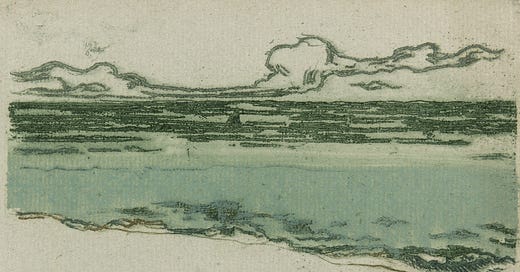I nose my rental car off the highway around 9 a.m., a meager breakfast and a bad night’s sleep twisting my stomach. To my left, a river emerges from a steep, narrow canyon, its current spreading wide across the valley before turning west toward the Pacific. A small knot of people is forming at the roadside, and I feel every muscle in my shoulders clench. Part of me wants to turn the key in the ignition and beat a path back to my hotel room, brew some bad Lipton, and curl in bed, indulge in the easy comfort of surrender. And, really, why not? How many miles have I driven since leaving home for these wide, high deserts wracked by ancient floods? Have I found even a fraction of what I’m looking for? I shiver. In the distant past, the canyon was cut by the softest touch, water sweeping away stone little by little, but the river slipping past my car isn’t the only force that carved those towering cliffs. A wild devastation made this land, and part of me—the part that has battled the needling voice in my head every mile of this road trip, every season of my adult life—wants to be overrun by it. I open the car door and let the deep, muddy smell of the water draw me to the cluster of people gathered along its edge.
At the center, a short, sparrow-boned man in his eighties stands chuckling at his own jokes, his lower jaw bouncing as if it’s recently been greased. Gene Kiver is a geology professor at the University of Eastern Washington and has led this eight-mile hike up Palouse River Canyon annually for the past four years. Before we set off, he spends fifteen minutes gesturing to a laminated map of the Pacific Northwest, sweeping his hand along the territories of vanished glaciers, ancient fault lines, and a lake nearly two thousand feet deep that once covered three thousand square miles of western Montana. At first, Glacial Lake Missoula kept to its bed because a spur of the Cordilleran Ice Sheet forced its way south through a gap in the Rockies, creating a dam across the mountain pass through which the water might have escaped. And it did escape. The rising flood pressed around its icy gates until they failed. Five hundred cubic miles of water rushed across Montana, Idaho, Washington, and Oregon to the Pacific in less than fourteen days. Then, very slowly, inch by inch, the glacier pushed south. The dam reformed. The water rose. The ice broke. Gene and his colleagues estimate that between thirteen and eighteen thousand years ago, the floods swept over these lands dozens of times.
As Gene leads us up the river into the canyon beyond, my tiny, time-limited mind tries to recreate those difficult numbers in material terms: five hundred cubic miles, fifteen thousand years ago, six hundred and fifty miles, fourteen days. Around me the land tips and drops in green slopes and brown cliffs. Rough, hexagonal columns of basalt rise in tiers from the river to the indistinct sky. I squint at the top of the canyon six hundred feet overhead and try to imagine that depth of water, the interference with sunlight, the rippling. The closest I come is a distorted memory of a time when, at age six or seven, I jumped into the deep end of the swimming pool on a cloudy July day, crouched on the cement bottom, opened my eyes, and looked up.
To read the entire essay (free February 10 - 24, after that viewable to Ecotone subscribers only).





Hi Annie, this was such a thrill to read in Ecotone, I think they sent me a copy I didn't remember ordering and I went right into your piece. I liked how you mixed in the romantic sublime of Saint-Exupery and Gene with your thoughts and the idea that we are entranced by thoughts of our own destruction and death. The realization at the end which connects to the title gave it resonance.